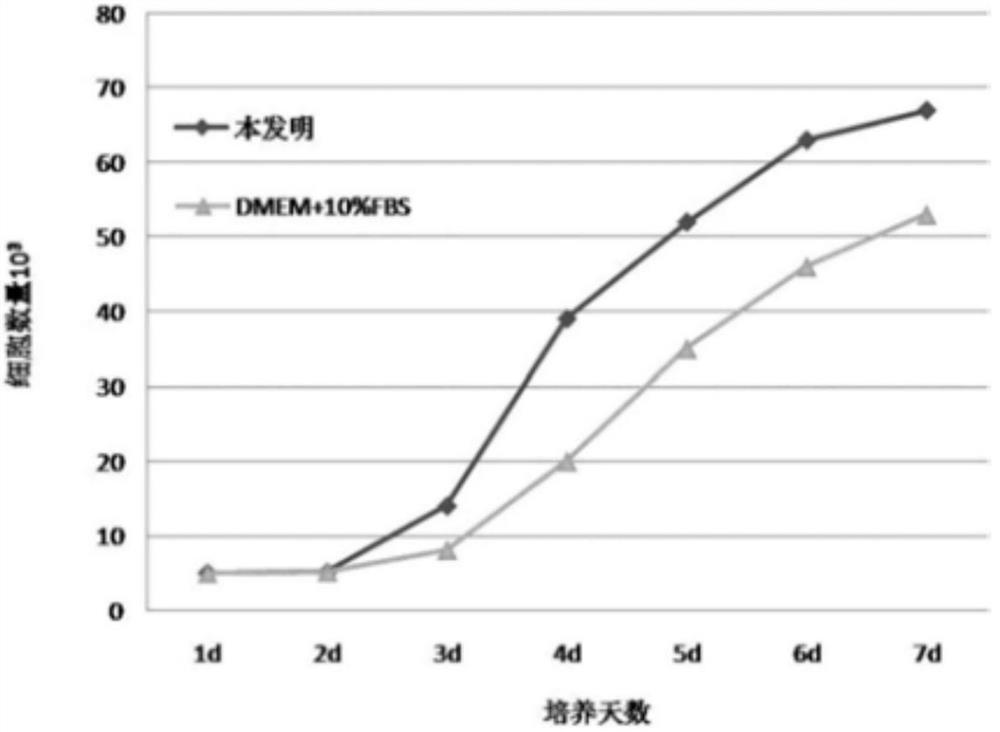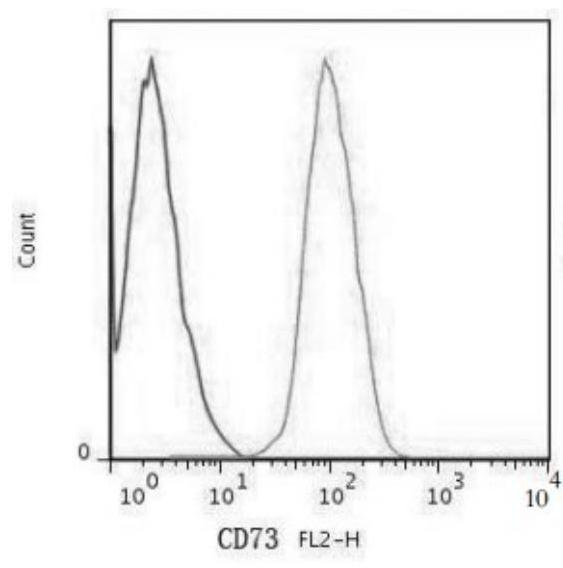Mesenchymal stem cell subculture method
A technology of quality stem cells and subculture, applied in the field of stem cell culture, can solve the problems of long cell growth cycle, weak proliferation ability and high price.
- Summary
- Abstract
- Description
- Claims
- Application Information
AI Technical Summary
Problems solved by technology
Method used
Image
Examples
Embodiment 1
[0032] This embodiment provides a method for subculture of human umbilical cord mesenchymal stem cells, comprising the following steps:
[0033] 1) Prepare serum-free subculture medium. The components of the serum-free subculture medium are: α-MEM medium, platelet-derived factor, fibroblast growth factor and ascorbic acid; the concentration of the platelet-derived factor is 10 ng / mL , in other preferred embodiments, the concentration of the platelet-derived factor is 11ng / mL, 12ng / mL, 13ng / mL, 14ng / mL, or 15ng / mL; the concentration of the fibroblast growth factor is 10ng / mL ; In other preferred embodiments, the concentration of the fibroblast growth factor is 11ng / mL, 12ng / mL, 13ng / mL, 14ng / mL or 15ng / mL; the concentration of ascorbic acid is 50 μg / mL, in other preferred In an embodiment, the ascorbic acid concentration is 25 μg / mL, 28 μg / mL, 30 μg / mL, 32 μg / mL, 35 μg / mL, 38 μg / mL, 40 μg / mL, 42 μg / mL, 45 μg / mL, 48 μg / mL or 49 μg / mL.
[0034] 2) Take primary human umbilical ...
Embodiment 2
[0036] This embodiment provides a serum-free subculture medium. The components of the serum-free subculture medium are: α-MEM medium, platelet-derived factor, fibroblast growth factor, and ascorbic acid; the concentration of the platelet-derived factor is 10ng / mL, in other preferred embodiments, the concentration of the platelet-derived factor is 11ng / mL, 12ng / mL, 13ng / mL, 14ng / mL or 15ng / mL; the concentration of the fibroblast growth factor is 10ng / mL / mL, in other preferred embodiments, the concentration of the platelet-derived factor is 11 ng / mL, 12 ng / mL, 13 ng / mL, 14 ng / mL or 15 ng / mL. The concentration of the ascorbic acid is 50 μg / mL, and in other preferred embodiments, the concentration of the ascorbic acid is 25 μg / mL, 28 μg / mL, 30 μg / mL, 32 μg / mL, 35 μg / mL, 38 μg / mL, 40 μg / mL , 42 μg / mL, 45 μg / mL, 48 μg / mL or 49 μg / mL.
[0037] The above-mentioned serum-free subculture medium added low concentrations of platelet-derived factor, fibroblast growth factor and ascorbic ...
Embodiment 3
[0040] This embodiment provides a serum-free subculture medium. The components of the serum-free subculture medium are: α-MEM medium, platelet-derived factor, fibroblast growth factor, ascorbic acid and melatonin; the platelet-derived The concentration of the factor is 15ng / mL, and in other preferred embodiments, the concentration of the platelet-derived factor is 10ng / mL, 11ng / mL, 12ng / mL, 13ng / mL or 14ng / mL; the fibroblast growth factor The concentration of the platelet-derived factor is 15ng / mL, and in other preferred embodiments, the concentration of the platelet-derived factor is 10ng / mL, 11ng / mL, 12ng / mL, 13ng / mL, 14ng / mL or 15ng / mL; Concentration is 25 μg / mL, in other preferred embodiments, the concentration of described ascorbic acid is 28 μg / mL, 30 μg / mL, 32 μg / mL, 35 μg / mL, 38 μg / mL, 40 μg / mL, 42 μg / mL, 45 μg / mL , 48 μg / mL, 49 μg / mL or 50 μg / mL; the content of the melatonin is 10 nM, and in other preferred embodiments, the content of the melatonin is 2 nM, 5 nM, 15 n...
PUM
| Property | Measurement | Unit |
|---|---|---|
| concentration | aaaaa | aaaaa |
| concentration | aaaaa | aaaaa |
| concentration | aaaaa | aaaaa |
Abstract
Description
Claims
Application Information
 Login to View More
Login to View More - R&D
- Intellectual Property
- Life Sciences
- Materials
- Tech Scout
- Unparalleled Data Quality
- Higher Quality Content
- 60% Fewer Hallucinations
Browse by: Latest US Patents, China's latest patents, Technical Efficacy Thesaurus, Application Domain, Technology Topic, Popular Technical Reports.
© 2025 PatSnap. All rights reserved.Legal|Privacy policy|Modern Slavery Act Transparency Statement|Sitemap|About US| Contact US: help@patsnap.com



